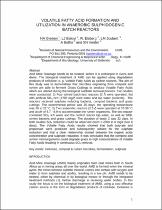 ResearchSpace
ResearchSpace
Volatile fatty acid formation and utilization in anaerobic sulphidogenic batch reactors
JavaScript is disabled for your browser. Some features of this site may not work without it.
- ResearchSpace
- →
- Research Publications/Outputs
- →
- Conference Publications
- →
- View Item
| dc.contributor.author |
Greben, HA

|
|
| dc.contributor.author |
Baloyi, LJ

|
|
| dc.contributor.author |
Eisberg, R

|
|
| dc.contributor.author |
Joubert, LM

|
|
| dc.contributor.author |
Botha, A

|
|
| dc.contributor.author |
Venter, SN

|
|
| dc.date.accessioned | 2009-01-19T13:21:08Z | |
| dc.date.available | 2009-01-19T13:21:08Z | |
| dc.date.issued | 2006-05 | |
| dc.identifier.citation | Greben, HA, Baloyi, LJ, Eisberg, R et al. 2006. Volatile fatty acid formation and utilization in anaerobic sulphidogenic batch reactors. Water Institute of South Africa Conference, Durban 21-24 May 2006, pp 12 | en |
| dc.identifier.uri | http://hdl.handle.net/10204/2840 | |
| dc.description | Water Institute of Southern Africa | en |
| dc.description.abstract | Acid Mine Drainage (AMD) needs to be treated, before it is recharged in rivers and dams. The biological treatment of AMD can be applied using degradation products of cellulose, for example Volatile Fatty Acids as carbon sources. The aim of this study was to demonstrate that microbes originating from compost and rumen are able to ferment grass cuttings to produce Volatile Fatty Acids which are utilized during the biological sulphate removal process. Two studies were conducted in the first study four stirred batch-test reactors (2 l) were operated, fed with artificial SO4 rich (1700 mg/l) feed water and tap water (controls). The reactors received sulphate reducing bacteria, compost bacteria and grass cuttings. The experimental period was 25 days; the operating temperature was 20 to 22 °C. In the second study two anaerobic reactors (2.5 l) were operated at 37-39 °C and at pH of 6.7 - 6.9 to accommodate the rumen organisms. The test reactor contained SO4 rich water and the control reactor tap water, as well as SRB, rumen bacteria and grass cuttings. The duration of the second study was 32 days. In both studies SO4 reduction could be observed (from ˜ 2000 to 0 mg/l over 8 days). The Volatile Fatty Acids results showed that both butyrate and propionate were produced and subsequently utilised for the sulphate reduction and that a clear relationship existed between the organic acids concentration and sulphate reduction. It was concluded that the compost and rumen microorganisms could degrade grass to high concentrations of Volatile Fatty Acids resulting in continuous SO4 removal | en |
| dc.language.iso | en | en |
| dc.subject | Acid mine drainage | en |
| dc.subject | Volatile fatty acids | en |
| dc.subject | Composite bacteria | en |
| dc.subject | Chemistry | en |
| dc.subject | Cellulose | en |
| dc.subject | Sulphate removal | en |
| dc.subject | Water institute of Southern Africa | en |
| dc.title | Volatile fatty acid formation and utilization in anaerobic sulphidogenic batch reactors | en |
| dc.type | Conference Presentation | en |
| dc.identifier.apacitation | Greben, H., Baloyi, L., Eisberg, R., Joubert, L., Botha, A., & Venter, S. (2006). Volatile fatty acid formation and utilization in anaerobic sulphidogenic batch reactors. http://hdl.handle.net/10204/2840 | en_ZA |
| dc.identifier.chicagocitation | Greben, HA, LJ Baloyi, R Eisberg, LM Joubert, A Botha, and SN Venter. "Volatile fatty acid formation and utilization in anaerobic sulphidogenic batch reactors." (2006): http://hdl.handle.net/10204/2840 | en_ZA |
| dc.identifier.vancouvercitation | Greben H, Baloyi L, Eisberg R, Joubert L, Botha A, Venter S, Volatile fatty acid formation and utilization in anaerobic sulphidogenic batch reactors; 2006. http://hdl.handle.net/10204/2840 . | en_ZA |
| dc.identifier.ris | TY - Conference Presentation AU - Greben, HA AU - Baloyi, LJ AU - Eisberg, R AU - Joubert, LM AU - Botha, A AU - Venter, SN AB - Acid Mine Drainage (AMD) needs to be treated, before it is recharged in rivers and dams. The biological treatment of AMD can be applied using degradation products of cellulose, for example Volatile Fatty Acids as carbon sources. The aim of this study was to demonstrate that microbes originating from compost and rumen are able to ferment grass cuttings to produce Volatile Fatty Acids which are utilized during the biological sulphate removal process. Two studies were conducted in the first study four stirred batch-test reactors (2 l) were operated, fed with artificial SO4 rich (1700 mg/l) feed water and tap water (controls). The reactors received sulphate reducing bacteria, compost bacteria and grass cuttings. The experimental period was 25 days; the operating temperature was 20 to 22 °C. In the second study two anaerobic reactors (2.5 l) were operated at 37-39 °C and at pH of 6.7 - 6.9 to accommodate the rumen organisms. The test reactor contained SO4 rich water and the control reactor tap water, as well as SRB, rumen bacteria and grass cuttings. The duration of the second study was 32 days. In both studies SO4 reduction could be observed (from ˜ 2000 to 0 mg/l over 8 days). The Volatile Fatty Acids results showed that both butyrate and propionate were produced and subsequently utilised for the sulphate reduction and that a clear relationship existed between the organic acids concentration and sulphate reduction. It was concluded that the compost and rumen microorganisms could degrade grass to high concentrations of Volatile Fatty Acids resulting in continuous SO4 removal DA - 2006-05 DB - ResearchSpace DP - CSIR KW - Acid mine drainage KW - Volatile fatty acids KW - Composite bacteria KW - Chemistry KW - Cellulose KW - Sulphate removal KW - Water institute of Southern Africa LK - https://researchspace.csir.co.za PY - 2006 T1 - Volatile fatty acid formation and utilization in anaerobic sulphidogenic batch reactors TI - Volatile fatty acid formation and utilization in anaerobic sulphidogenic batch reactors UR - http://hdl.handle.net/10204/2840 ER - | en_ZA |





